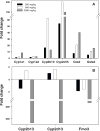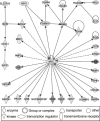Gene expression profiling as an initial approach for mechanistic studies of toxicity and tumorigenicity of herbal plants and herbal dietary supplements
- PMID: 20390968
- PMCID: PMC5736312
- DOI: 10.1080/10590500903585416
Gene expression profiling as an initial approach for mechanistic studies of toxicity and tumorigenicity of herbal plants and herbal dietary supplements
Abstract
Dietary supplements are consumed by more than 300 million people worldwide, and herbal dietary supplements represent the most rapidly growing portion of this industry. Even though adverse health effects of many herbal dietary supplements have been reported, safety assurances are not being addressed adequately. Toxicological data on the identification of genotoxic and tumorigenic ingredients in many raw herbs are also lacking. Currently, more than 30 herbal dietary supplements and active ingredients have been selected by the National Toxicology Program (NTP) for toxicity and tumorigenicity studies. Due to the complexity of the chemical components present in plant extracts, there are no established methodologies for determining the mechanisms of toxicity (particularly tumorigenicity) induced by herbs, such as Gingko biloba leaf extract (GBE) and other herbal plant extracts. Consequently, the understanding of toxicity of herbal dietary supplements remains limited. We have proposed that application of DNA microarrays could be a highly practical initial approach for revealing biological pathways and networks associated with toxicity induced by herbal dietary supplements and the generation of hypotheses to address likely mechanisms. The changes in expression of subsets of genes of interest, such as the modulation of drug metabolizing genes, can be analyzed after treatment with an herbal dietary supplement. Although levels of gene expression do not represent fully the levels of protein activities, we propose that subsequent biochemical and genomic experiments based on these initial observations will enable elucidation of the mechanisms leading to toxicity, including tumorigenicity. This review summarizes the current practices of microarray analysis of gene expressions in animals treated with herbal dietary supplements and discusses perspectives for the proposed strategy.
Figures





Similar articles
-
Quality assurance and safety of herbal dietary supplements.J Environ Sci Health C Environ Carcinog Ecotoxicol Rev. 2009 Apr;27(2):91-119. doi: 10.1080/10590500902885676. J Environ Sci Health C Environ Carcinog Ecotoxicol Rev. 2009. PMID: 19412857 Review.
-
Ginkgo biloba extract induces gene expression changes in xenobiotics metabolism and the Myc-centered network.OMICS. 2010 Feb;14(1):75-90. doi: 10.1089/omi.2009.0115. OMICS. 2010. PMID: 20141330 Free PMC article.
-
DNA Barcoding for the Identification of Botanicals in Herbal Medicine and Dietary Supplements: Strengths and Limitations.Planta Med. 2016 Sep;82(14):1225-35. doi: 10.1055/s-0042-111208. Epub 2016 Jul 8. Planta Med. 2016. PMID: 27392246 Review.
-
Regulatory landscape of dietary supplements and herbal medicines from a global perspective.Regul Toxicol Pharmacol. 2020 Jul;114:104647. doi: 10.1016/j.yrtph.2020.104647. Epub 2020 Apr 16. Regul Toxicol Pharmacol. 2020. PMID: 32305367 Review.
-
Hepatotoxicity and tumorigenicity induced by metabolic activation of pyrrolizidine alkaloids in herbs.Curr Drug Metab. 2011 Nov;12(9):823-34. doi: 10.2174/138920011797470119. Curr Drug Metab. 2011. PMID: 21619520 Review.
Cited by
-
The role of CYP 3A4 and 1A1 in amiodarone-induced hepatocellular toxicity.Toxicol Lett. 2016 Jun 24;253:55-62. doi: 10.1016/j.toxlet.2016.04.016. Epub 2016 Apr 22. Toxicol Lett. 2016. PMID: 27113703 Free PMC article.
-
Mechanism study of goldenseal-associated DNA damage.Toxicol Lett. 2013 Jul 31;221(1):64-72. doi: 10.1016/j.toxlet.2013.05.641. Epub 2013 Jun 5. Toxicol Lett. 2013. PMID: 23747414 Free PMC article.
-
Endoplasmic reticulum stress in drug- and environmental toxicant-induced liver toxicity.J Environ Sci Health C Environ Carcinog Ecotoxicol Rev. 2014;32(1):83-104. doi: 10.1080/10590501.2014.881648. J Environ Sci Health C Environ Carcinog Ecotoxicol Rev. 2014. PMID: 24598041 Free PMC article. Review.
-
A Balanced Risk-Benefit Analysis to Determine Human Risks Associated with Pyrrolizidine Alkaloids (PA)-The Case of Tea and Herbal Infusions.Nutrients. 2017 Jul 7;9(7):717. doi: 10.3390/nu9070717. Nutrients. 2017. PMID: 28686224 Free PMC article. Review.
-
Up-and-coming anti-epileptic effect of aloesone in Aloe vera: Evidenced by integrating network pharmacological analysis, in vitro, and in vivo models.Front Pharmacol. 2022 Aug 12;13:962223. doi: 10.3389/fphar.2022.962223. eCollection 2022. Front Pharmacol. 2022. PMID: 36034878 Free PMC article.
References
-
- Zurer P, Hanson D. Chemistry puts herbal supplements to the test. Chemical & Engineering News. 2004;82:16.
-
- Ho CH, Simon JC, Shahidi F, Shao Y. Dietary supplements: an overview. Washington, DC: Dietary Supplements (ACS Symposium Series 987), American Chemical Society; 2008. pp. 2–8.
-
- Arneborn P, Jansson A, Bottiger Y. [Acute hepatitis in a woman after intake of slimming pills bought via Internet] Lakartidningen. 2005;102:2071–2. - PubMed
-
- Bujanda L, Palacios A, Silvarino R, Sanchez A, Munoz C. [Kava-induced acute icteric hepatitis] Gastroenterol. Hepatol. 2002;25:434–5. - PubMed
-
- CDC. Hepatic toxicity possibly associated with kava-containing products—United States, Germany, and Switzerland, 1999–2002. Morbidity and Mortality Weekly Reports (MMWR) 2002:1065–67. - PubMed
Publication types
MeSH terms
Substances
Grants and funding
LinkOut - more resources
Full Text Sources
Medical
